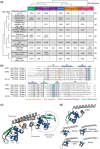The Lrs14 family of DNA-binding proteins as nucleoid-associated proteins in the Crenarchaeal order Sulfolobales
- PMID: 38567765
- PMCID: PMC11841832
- DOI: 10.1111/mmi.15260
The Lrs14 family of DNA-binding proteins as nucleoid-associated proteins in the Crenarchaeal order Sulfolobales
Abstract
Organization of archaeal chromatin combines bacterial, eukaryotic, and unique characteristics. Many archaeal lineages harbor a wide diversity of small and highly expressed nucleoid-associated proteins, which are involved in DNA structuring. In Sulfolobales, representing model organisms within the Crenarchaeota, Sul7d, Cren7, Sul10a, and Sul12a are well-characterized nucleoid-associated proteins. Here, we combine evidence that the Lrs14 family of DNA binders is part of the repertoire of nucleoid-associated proteins in Sulfolobales. Lrs14-encoding genes are widespread within genomes of different members of the Sulfolobales, typically encoded as four to nine homologs per genome. The Lrs14 proteins harbor a winged helix-turn-helix DNA-binding domain and are typified by a coiled-coil dimerization. They are characterized by distinct sequence- and structure-based features, including redox-sensitive motifs and residues targeted for posttranslational modification, allowing a further classification of the family into five conserved clusters. Lrs14-like proteins have unique DNA-organizing properties. By binding to the DNA nonsequence specifically and in a highly cooperative manner, with a slight preference for AT-rich promoter regions, they introduce DNA kinks and are able to affect transcription of adjacent transcription units either positively or negatively. Genes encoding Lrs14-type proteins display considerable differential expression themselves in response to various stress conditions, with certain homologs being specific to a particular stressor. Taken together, we postulate that members of the Lrs14 family can be considered nucleoid-associated proteins in Sulfolobales, combining a DNA-structuring role with a global gene expression role in response to stress conditions.
Keywords: Crenarchaeota; DNA binding; Lrs14; archaea; chromatin organization; winged helix‐turn‐helix.
© 2025 The Authors. Molecular Microbiology published by John Wiley & Sons Ltd.
Conflict of interest statement
The authors declare no competing interests.
Figures


Similar articles
-
DNA-Binding Properties of a Novel Crenarchaeal Chromatin-Organizing Protein in Sulfolobus acidocaldarius.Biomolecules. 2022 Mar 30;12(4):524. doi: 10.3390/biom12040524. Biomolecules. 2022. PMID: 35454113 Free PMC article.
-
An Lrp-like protein of the hyperthermophilic archaeon Sulfolobus solfataricus which binds to its own promoter.J Bacteriol. 1999 Mar;181(5):1474-80. doi: 10.1128/JB.181.5.1474-1480.1999. J Bacteriol. 1999. PMID: 10049378 Free PMC article.
-
Crystal structure of the crenarchaeal conserved chromatin protein Cren7 and double-stranded DNA complex.Protein Sci. 2010 Jun;19(6):1253-7. doi: 10.1002/pro.385. Protein Sci. 2010. PMID: 20512977 Free PMC article.
-
Archaea: The Final Frontier of Chromatin.J Mol Biol. 2021 Mar 19;433(6):166791. doi: 10.1016/j.jmb.2020.166791. Epub 2020 Dec 29. J Mol Biol. 2021. PMID: 33383035 Free PMC article. Review.
-
Chromatin and gene regulation in archaea.Mol Microbiol. 2025 Mar;123(3):218-231. doi: 10.1111/mmi.15302. Epub 2024 Aug 3. Mol Microbiol. 2025. PMID: 39096085 Free PMC article. Review.
Cited by
-
Transcriptional landscape of the cell cycle in a model thermoacidophilic archaeon reveals similarities to eukaryotes.Nat Commun. 2025 Jul 1;16(1):5697. doi: 10.1038/s41467-025-60613-8. Nat Commun. 2025. PMID: 40593522 Free PMC article.
References
-
- Abella, M. , Rodriguez, S. , Paytubi, S. , Campoy, S. , White, M.F. & Barbe, J. (2007) The Sulfolobus solfataricus radA paralogue sso0777 is DNA damage inducible and positively regulated by the Sta1 protein. Nucleic Acids Research, 35, 6788–6797. Available from: 10.1093/nar/gkm782 - DOI - PMC - PubMed
-
- Alpha‐Bazin, B. , Gorlas, A. , Lagorce, A. , Joulié, D. , Boyer, J.B. , Dutertre, M. et al. (2021) Lysine‐specific acetylated proteome from the archaeon Thermococcus gammatolerans reveals the presence of acetylated histones. Journal of Proteomics, 232, 1–11. Available from: 10.1016/j.jprot.2020.104044 - DOI - PubMed
-
- Auernik, K.S. , Maezato, Y. , Blum, P.H. & Kelly, R.M. (2008) The genome sequence of the metal‐mobilizing, extremely thermoacidophilic archaeon Metallosphaera sedula provides insights into bioleaching‐associated metabolism. Applied and Environmental Microbiology, 74, 682–692. Available from: 10.1128/AEM.02019-07 - DOI - PMC - PubMed
Publication types
MeSH terms
Substances
Grants and funding
LinkOut - more resources
Full Text Sources

